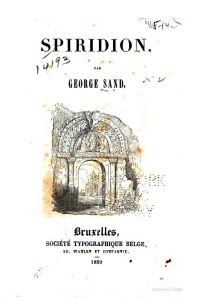When an author or translator completes a novel, the work is not over by a long shot. She then has to seek out a publisher, another endurance test a lot like job-seeking. When one says ‘Yes, I’ll publish it,’ the author might then think she can hand her work over, sit back and get on with the next book. But no, for the author is expected to be involved in the marketing of her own work… This is a writer’s fact of life that I’m slowly learning.
Part of the marketing involves getting readers to write reviews. Good or bad, apparently they all lead to sales. The publisher of my translation of George Sand’s Spiridion had offered to send it out for reviews, but none have appeared. Three kind readers have voluntarily reviewed it on Amazon and Goodreads. But if I want to pique the interest of more buyers, and perhaps eventually be paid a little something, I have to be proactive. A recommended road is the one that leads to literature bloggers. Out of four I contacted, one responded, Francine Maessen at booksien.com. She asked for a copy of the book, which I bought and sent, and then I waited eight months while she completed some university studies, and now, finally, her long and positive review is available on her blog. She’s also written a brief review for Goodreads. Proactivity pays.
Francine praised Sand’s writing, which is indirectly a compliment for me:
George Sand’s writing is just amazing. She is seen as one of the best writers of her period, even better than Honoré de Balzac. What I personally enjoy so much about her style in this specific novel, is that she still uses the beautiful style we know from realist writers for such a different genre as the gothic novel.
Another literary translator today recommended a website that seeks out translated European books for review, the European Literature Network. Since, after nearly three years, my Spiridion account is still in the red, I’ve got nothing to lose by pointing them to my book.
If you’ve read this far you might like to know a bit about Spiridion by George Sand. Published in 1839 initially, then revised and re-published in 1842, it’s a gothic philosophical novel with a little horror and a lot of analysis of the Catholic monastery as an institution and its corrupting potential for men locked away from women and the rest of the world. The founder of this fictional monastery dies and haunts the cloisters for years, searching for a monk who is uncorrupted, who has the courage to go down into the crypt to seek the truth, which turns out to be a grim experience for a young novice.
When I first read the French version I easily imagined the creepiness of the monastery and its tenants, but I found the illustrations available online added to the pleasure of it.


First, I liked the images used to illustrate an old version published in Brussels, and was pleased to see the cover chosen for mine by SUNY Press, both of them featuring an arched entrance to a mysterious cloister.
Here’s a hint if you buy the English translation: look up the illustrations in the original French version from 1839 (mine is from the revised 1842 edition), available freely online, illustrated by Tony Johannot and George Sand’s son, Maurice. You’ll see images of the monastery, its corrupt monks, a couple of good souls, and the ghostly founder.

Thank you, Francine Maessen, for reading and reviewing Spiridion!
*
